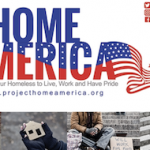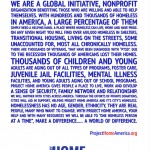A homeless man rests on top of a subway vent grate as tourist walk past, in Washington, DC on Jan. 5, 2018.(ANDREW CABALLERO-REYNOLDS/AFP/GETTY IMAGES)
Washington state Sen. Curtis King (R-Takima) recently proposed not allowing homeless shelters, or even organizations that serve the homeless, to be located within 1,000 feet of a school. The reason apparently is to keep children from being exposed to alcohol or marijuana use (dispensaries and liquor stores are also beholden to the 1,000-feet rule).
In San Francisco and Denver, homeless advocates are facing off with city officials who destroyed tent cities, demanding that the city offer more social services for the homeless. In San Francisco, sweeps during inclement weather prevented people from sleeping in public areas even though the homeless shelters were full and the homeless had nowhere else to go.
Some observers see the homeless as “less than” and a target for blame for violent crimes. Yet those who are homeless are much more likely to be victims of crimes than perpetrators. The most visible homeless – those who panhandle on the streets – are only a small portion of the total homeless population.
According to the U.S. Department of Health and Human Services, homelessness is defined as lacking housing, whether the person sleeps on the streets, in a shelter, or in the homes of friends and family members. An estimated 553,742 individuals are homeless, per a January 2017 point-in-time count.
The reasons people become homeless vary; addiction and mental health disorders are often cited, but they are not the most common reasons. The institutional practices at work – lack of a livable wage, affordable housing and medical debt – are major reasons one becomes homeless.
As a nurse who helps to run an interprofessional, student-led clinic in a Chicago homeless shelter, I am struck by how quickly some of my patients report their lives changed.
One patient suffered a traumatic injury that prevented him from working. Without a paycheck, he quickly lost his apartment and car and turned to the shelter. Another woman left an abusive relationship and did not have anywhere to go; her family does not live in the area. Many patients have laborer jobs where they work all day and return to the shelter at night. Unfortunately their pay is so low, they cannot afford an apartment.
One-third of the homeless are families with children. Veterans from all wars since World War II comprise 11 percent of the homeless. According to financial aid applications, 68,000 college students identify as homeless.
In an age where the value of human life is discussed on a national stage, policymakers and pundits often do not consider the homeless an urgent part of the conversation.
The homeless are at higher risk for communicable diseases, especially hepatitis A, which disproportionately affects the homeless because of a lack of access to clean water, lack of access to sanitation and close contact to those already infected. The virus spreads quickly, making outbreaks hard to stop. Hepatitis A outbreaks in Delaware, Florida, and South Carolinafollow a two-year outbreak that just ended in Utah.
Solutions to end homelessness are complicated. Quite simply, not enough government-funded social programs exist to aid the homeless in a meaningful way. Small community groups pop up to bridge the gap, but it is nearly impossible to gather data about their efficacy – and because of the increased risk for communicable diseases, their attempts to provide services to the homeless can be ineffectual and even cause harm.
During the 2018 Thanksgiving season, a group called Free Hot Soup KC attempted to serve food to the homeless. The group lacked food-handling certifications and a permit, so the Kansas City Health Department tried to stop them, pouring bleach on the food to make it impossible to serve – sparking outrage instead of taking the opportunity to educate Free Hot Soup KC about the larger health risks homeless populations face.
Individuals can extend generosity, such Candice Payne in Chicago, who paid for 72 hotel rooms for the homeless for five nights during a recent polar vortex of frigid temperatures. But beyond the threats of cold weather and the surge of holiday volunteerism at shelters, all Americans need to be more intentional concerning services to the homeless all year round.
Organizations can make concerted efforts, as in Oregon where community organization groups worked with a motel to lower room rates and to rent out 45 rooms for the homeless. Bombas, a sock company, has donated over 8 million pairs of socks to homeless shelters over the past six years.
But there will not be lasting, effective change until policymakers at all levels of government treat homelessness as the national emergency it is. Building more affordable housing, expanding Medicaid and raising the minimum wage will address the major causes of homelessness.
Last fall, H.R. 6157 was signed into law, increasing funding for affordable housing and education programs for the homeless. This is a great start, but more needs to be done.
Bridging the gap between public policy and the needs of the homeless, this urgent issue needs attention from every sector possible – individual, public, private and institutional. It’s only human.







